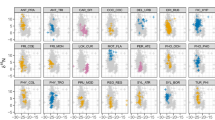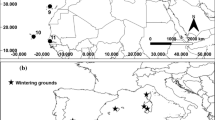Abstract
Altitudinal migration and dispersal is an important component of the life history of several temperate and tropical birds but remains poorly understood due to the limited success of mark and recapture techniques. Stable isotopes of hydrogen (δD) in rainfall, and to a lesser extent, carbon (δ13C) in plants are known to change with altitude and hence may provide the basis of a technique for tracking the altitudinal movements in birds and other wildlife. We investigated the potential for this technique by measuring δ13C, δD, and δ15N values in tail feathers of eight species of hummingbirds (Phaethornis malaris, P. syrmatophorus, P. guy, Adelomyia melanogenys, Coeligena torquata, C. lutetiae, Metallura baroni, M. williami) along an altitudinal gradient (300–3,290 m asl) in the Andes Mountains of Ecuador. Feather δ13C and δD values were correlated and each changed significantly with elevation above 400 m. In general, we found good agreement between feather δD values and those predicted from a generalized relationship of precipitation and surface water δD with altitude. Similarly, feather δ13C values showed an enrichment of ~1.5‰ per 1,000 m over the linear portion of the elevational response. Stable-nitrogen isotope values were variable, and so did not provide useful information on elevation in birds, apart from trophic effects. Overall there appears to be good potential for using the (δD, δ13C) stable isotope approach to track altitudinal movements and to elucidate previously unrecognized patterns of life history variation in both temperate and tropical species that migrate across elevational isotopic gradients.



Similar content being viewed by others
References
Baldwin PH (1953) Annual cycle, environment and evolution in the Hawaiian honeycreepers (Aves: Drepaniidae). Univ Calif Publ Zool 52:285–398
Berthold P (2001) Bird migration: a general survey. Oxford University Press, Oxford
Bowen GJ, Wilkinson B (2002) Spatial distribution of δ18O in precipitation. Geology 30(4):315–318
Chamberlain CP, Bluhm JD, Holmes RT, Feng X, Sherry TW, Graves GR (1997) The use of isotope tracers for identifying populations of migratory birds. Oecologia 109:132–141
Craig H (1961) Isotopic variations in meteoric water. Science 133:1702–1703
Dansgaard W (1964) Stable isotopes in precipitation. Tellus 16:436–468
Dawson TE, Mambelli S, Plamboeck AH, Templer PH, Tu KP (2002) Stable isotopes in plant ecology. Annu Rev Ecol Syst 33:507–560
Dixon KL, Johnson JD (1964) Altitudinal migration in the mountain chickadee. Condor 66:61–64
Graves GR, Romanek CS, Navarro AR (2002) Stable isotope signature of philopatry and dispersal in a migratory songbird. Proc Natl Acad Sci 99:8096–8100
Gröcke DR, Bocherens H, Mariotti A (1997) Annual rainfall and nitrogen isotope correlation in macropod collagen: applications as a paleoprecipitation indicator. Earth Planet Sci Lett 153:279–285
Hebert CE, Wassenaar LI (2001) Stable nitrogen isotopes in waterfowl feathers reflect agricultural land use in western Canada. Environ Sci Technol 35:3482–3487
Hobson KA (1999a) Tracing origins and migration of wildlife using stable isotopes: a review. Oecologia 120:314–326
Hobson KA (1999b) Stable-carbon and nitrogen isotope ratios of songbird feathers grown in two terrestrial biomes: implications for evaluating trophic relationships and breeding origins. Condor 101:799–805
Hobson KA (2002) Making migratory connections with stable isotopes. In: Berthold P, Gwinner E, Sonnenschein E (eds) Avian migration. Springer, Berlin Heidelberg New York
Hobson KA, Wassenaar LI (1997) Linking breeding and wintering grounds of neotropical migrant songbirds using stable hydrogen isotopic analysis of feathers. Oecologia 109:142–148
Hobson KA, Wassenaar LI (2001) A stable isotope approach to delineating population structure in migratory wildlife in North America: an example using the loggerhead shrike. Ecol Appl 11:1545–1553
Hobson KA, McFarland KP, Wassenaar LI, Rimmer CC, Goetz JE (2001) Linking breeding and wintering grounds of Bicknell's thrushes using stable isotope analyses of feathers. Auk 118:16–23
Hultine KR, Marshall JD (2000) Altitude trends in conifer leaf morphology and stable carbon isotope composition. Oecologia 123:32–40
IAEA (2001) Isotope hydrology information system. The ISOHIS database. Accessible at: http://isohis.iaea.org
Johnson DN, Maclean GL (1994) Altitudinal migration in Natal ostrich 65:86–94
Johnston-Stewart N, Hammer DB (1988) Altitudinal migrants. Nyala 12:77–80
Kelly JF, Atudorei V, Sharp ZD, Finch DM (2001) Insights into Wilson's warbler migration from analyses of hydrogen stable-isotope ratios. Oecologia 130:216–221
Körner C, Diemer M (1987) In situ photosynthetic responses to light, temperature and carbon dioxide in herbaceous plants from low and high altitude. Funct Ecol 1:179–194
Körner C, Farquhar GD, Roksandic, Z (1988) A global survey of carbon isotope discrimination plants from high altitude. Oecologia 74:623–632
Körner C, Farquhar GD, Wong SC (1991) Carbon isotope discrimination by plants follows latitudinal and altitudinal trends. Oecologia 74:623–632
Lajtha K, Marshall JD (1994) Sources of variation in the stable isotopic composition of plants. In: Lajtha K, Michener RH (eds) Stable isotopes in ecology and environmental sciences. Blackwell, Oxford, pp 1–21
Laymon SA (1989) Altitudinal migration movements of spotted owls in the Sierra Nevada, California. Condor 91:837–841
Lindstrom A, Visser GH, Daan D (1993) Physiol Zool 66:490–510
Loiselle BA, Blake JG (1991) Temporal variation in birds and fruits along an elevational gradient. Ecology 72:180–193
Mariotti A, Pierre D, Vedy JC, Bruckert S, Guillemot J (1980) The abundance of natural nitrogen-15 in the organic matter of soils along an altitudinal gradient. Catena 7:293–300
Marshall JD, Zhang J (1994) Carbon isotope discrimination and water-use efficiency in native plants of the north-central Rockies. Ecology 75:1887–1895
Meehan TD, Lott CA, Sharp ZD, Smith RB, Rosenfield RN, Stewart AC, Murphy RK (2001) Using hydrogen isotope geochemistry to estimate the natal latitudes of immature Cooper's hawks migrating through the Florida Keys. Condor 103:11–20
Moreau RE (1966) The bird faunas of Africa and its islands. Academic Press, New York
Nadelhoffer KJ, Fry B (1994) Nitrogen isotopes studies in forest ecosystems. In: Lajtha K, Michener RH (eds) Stable isotopes in ecology and environmental science. Blackwell, Oxford, pp 22–44
Poage MA, Chamberlain CP (2001) Empirical relationships between elevation and the stable isotope composition of precipitation and surface waters: considerations for studies of paleoelevational change. Am J Sci 301:1–15
Powell GVN, Bjork J (1994) Implications of altitudinal migration for conservation strategies to protect tropical biodiversity: a case study of the resplendent quetzal Pharomachrus mocinno at Monteverde, Costa Rica. Bird Conserv Int 4:161–174
Rabenold KN, Rabenold PP (1985) Variation in altitudinal migration, winter segregation, and site tenacity in two subspecies of dark-eyed juncos in the southern Appalachians. Auk 102:805–819
Ridgely RS, Greenfield JP (2001) The birds of Ecuador. Cornell University Press, Ithaca, N.Y.
Rubenstein DR, Chamberlain CP, Holmes RT, Ayres MP, Waldbauer JR, Graves GR, Tuross NC (2002) Linking breeding and wintering ranges of a migratory songbird using stable isotopes. Science 295:1062–1065
Siegenthaler U, Oeschger H (1980) Correlation of 18O in precipitation with temperature and altitude. Nature 285:189–223
Sparks JP, Ehleringer JR (1997) Leaf carbon isotope discrimination and nitrogen content for riparian trees along elevational transects. Oecologia 109:362–367
Wassenaar LI, Hobson KA (2000a) Stable-carbon and hydrogen isotope ratios reveal breeding origins of red-winged blackbirds. Ecol Applic 10:911–916
Wassenaar LI, Hobson KA (2000b) Improved method for determining the stable-hydrogen isotopic composition (δD) of complex organic materials of environmental interest. Environ Sci Technol 34:2354–2360
Wassenaar LI, Hobson KA (2001) A stable-isotope approach to delineate geographical catchment areas of avian migration monitoring stations in North America. Environ Sci Technol 35:1845–1850
Wassenaar, LI, Hobson, KA (2003) Rapid online technique for determinations of non-exchangeable δD of keratins for animal migration studies. Isotopes Environ Health Stud 39:1
Webster MS, Marra PP, Haig SM, Bensch S, Holmes RT (2002) Links between worlds: unraveling migratory connectivity. Trends Ecol Evol 17:76–83
Acknowledgements
We thank Patricia Healy for assistance in preparing feather samples for stable isotope analysis. Hydrogen isotope samples were analyzed at the National Water Research Institute, Saskatoon, Saskatchewan, Canada, and C and N isotope samples were analyzed at the Department of Soil Science, University of Davis, Davis, California, with the help of David Harris. Funding was provided by a Canadian Wildlife Service operating grant to K. A. H. and an Environment Canada operating grant to L. I. W. We thank G. Castañeda, J. Chaves, J. Freile, O. Rodriguez, B. Ryder, and T. Santander, for assistance in the field, L. Coloma, Museo de Zoología, Universidad Católica del Ecuador, the staff at CECIA and H. Greeney for support. This work was also supported by NSF grant IRCEB-9977072 to T. B. S. Constructive comments on an earlier manuscript were made by Todd Dawson and two anonymous reviewers.
Author information
Authors and Affiliations
Corresponding author
Rights and permissions
About this article
Cite this article
Hobson, K.A., Wassenaar, L.I., Milá, B. et al. Stable isotopes as indicators of altitudinal distributions and movements in an Ecuadorean hummingbird community. Oecologia 136, 302–308 (2003). https://doi.org/10.1007/s00442-003-1271-y
Received:
Accepted:
Published:
Issue Date:
DOI: https://doi.org/10.1007/s00442-003-1271-y




